Abstract
In response to the lack of ability to handle multidimensional data in current research methods for shared bicycle travel patterns, and the fact that correlation analysis is only conducted on a single feature, this study investigates the travel pattern using tensor decomposition and a random forest model. Based on the riding data of dockless shared bicycles in Shenzhen, tensor decomposition is applied to extract three shared bicycle travel patterns: peak-high traffic pattern, steady traffic pattern, and off-peak high traffic pattern. Spatially, each pattern exhibits clustering, and the travel volume decreases from the center to the periphery. Based on this, with 13 built environment factors as feature variables, a random forest model is trained. Importance and interaction analyses are performed for both individual features and feature combinations. The results indicate that the random forest model demonstrates excellent fitting performance and accuracy. Furthermore, for the peak-high traffic pattern, the combination of the length of primary roads and the number of companies contributes the most, while for the steady traffic pattern, it is the combination of the number of malls and companies. Finally, for the off-peak high traffic pattern, the influence of the number of malls and interests is the most significant.
1. Introduction
With the introduction of the carbon peak and carbon neutrality policy [1], the development of Chinese cities should place more emphasis on sustainability, and urban transportation should also become more low-carbon and environmentally friendly. Therefore, management and decision-making departments encourage the development of public transportation systems to reduce private car use, alleviate traffic congestion [2], and promote green travel. Shared bicycles combine the attributes of low-carbon and public transportation, making them highly suitable for short-distance travel. Among them, dockless shared bicycles, which do not require docking stations, offer greater flexibility compared to traditional shared bicycle systems and have proven particularly effective in addressing the ‘first kilometer’ and ‘last kilometer’ issues. In recent years, they have been widely promoted across the country.
Despite the rapid proliferation of shared bicycles, which has greatly facilitated daily travel, it has also brought challenges in urban traffic flow management [3], vehicle parking [4], and other management issues. Moreover, appropriately distributing the number of shared bicycles across different areas to reduce potential human and material resource consumption is also a key task for current urban decision-making bodies [5]. A key prerequisite for addressing these issues is the reasonable definition of shared bicycle travel patterns, a complex and multidimensional process that involves data collection and construction, pattern extraction [6], travel volume prediction [7], and other interdisciplinary knowledge. The integrated use of this knowledge to provide accurate pattern definitions can offer strong support and guidance for the deployment, operation, and scheduling management of shared bicycles.
Scholars have conducted research in this area. For example, Du et al. [8] defined three main travel patterns in the dockless shared bicycle system based on origin–destination (OD) points, including origin–destination pattern, travel cycle pattern, and transfer pattern. Xing et al. [9] performed K-means clustering of shared bicycle travel patterns based on travel records and data on points of interest (POI) around OD points. Kou et al. [10] compared the actual duration of trips with the expected duration estimated by the Google Maps API, classifying them into two patterns: commuting and tourist travel. Li et al. [11] identified cycling districts and constructed a shared bicycle flow network by using network clustering algorithms based on OD points of shared bicycle trips. Also, Ma et al. [12] analyzed factors such as educational quality, population and business density, and subway station density based on the shared bicycle–subway transfer volume during weekdays and weekends in cities. According to the distribution of the data set, Wang et al. [13] defined trips with a trip of 0.1–1.5 km as short trips, and trips with a trip greater than 1.5 km as long trips. Quan et al. [14] introduced the cycling intensity indicator to explore the spatiotemporal patterns of shopping and travel in the main urban area of Nanjing by analyzing OD correlation. It is evident that there is currently no unified consensus on the definition and classification standards for shared bicycle travel patterns. The extraction of travel patterns relies on human-defined features based on time (trip duration) or spatial characteristics (OD points and POI). Both time and spatial features are considered in the work of Wang et al. [15], who analyzed the travel behavior of shared bicycles from a regional perspective, used a non-negative matrix factorization (NMF) [16] algorithm to extract the travel patterns of shared bicycles, and used a Poisson regression model to explain each pattern. After using the Infomap algorithm to determine the clustering level, Li et al. [17] extracted the travel pattern of shared bicycles through the NMF algorithm. However, as the dimensionality of the dataset and the number of features included increase, the methods used in these studies may lead to information loss due to the lack of multidimensional processing capabilities.
Additionally, urban built environments play a significant role in shaping shared bicycle travel patterns. Different functions of the built environment create variations in travel patterns across time and space, thus affecting the demand distribution of bicycles. In studying the relationship between environmental variables and travel patterns, Dong et al. [18] proposed a new framework combined with an extreme gradient lift tree model to assess the impact and threshold effects of the built environment on bike-sharing usage. Chen et al. [19] used a multi-scale geographical weighted regression model to study the impact of riding environments such as street view images (SVI) and road networks on the use of shared bicycles. After determining the optimal spatial unit clustering method for the flow of dockless shared bicycles, Ethier et al. [20] used spatially dynamic activity spaces to examine the relationship between building environment variables and shared bicycle travel volume. Song et al. [21] used the integrated learning method to explore the nonlinear influence and interaction of the built environment on the dockless bike-sharing system near subway stations. Li et al. [22] applied ordinary least squares, geographically weighted regression, and multiscale geographically weighted regression models to capture the multiscale relationships between urban built environments and subway-oriented dockless shared bicycle usage. Yang et al. [23] used a gradient boosting decision tree model to identify the nonlinear effects and threshold effects of the built environment on the usage of shared electric bicycles. Zhuang et al. [24] used a gradient boosting decision tree model to explore the nonlinear effects of the built environment and traffic conditions on street-level dockless shared bicycle trips. Zhang et al. [25] used a multiple linear regression model to examine the effects of built environment variables on travel demand and the supply–demand ratio of bicycle stations. Guo et al. [26] conducted a series of negative binomial regressions to study the impact of the built environment on the combined usage of dockless shared bicycles and the subway. In studies conducted in other countries worldwide, Silvestri et al. [27] introduced a decision support system to provide recommendations for optimizing bicycle infrastructure in Milan, Italy, based on observable factors such as availability and quality of cycleways, as well as latent factors such as user safety and security. Coppola et al. [28] studied the impact of attitudes and individual gender on the perception of building environments, including train stations and bike lanes, in a medium-sized Italian railway station. Villarrasa-Sapiña et al. [29] used nonlinear analysis to explore the impact of meteorological conditions in 13 cities in Europe and North America on the use of bike sharing systems. These works explore users’ perspectives on climate, built environment, and infrastructure safety based on a demand-oriented approach. However, these studies typically analyze the relationship between a single environmental variable and travel patterns, overlooking the possibility that combinations of environmental variables may have effects on travel patterns that are entirely different from those of a single variable.
To address the aforementioned issues, this study constructs a three-dimensional tensor from historical shared bicycle travel data and applies tensor decomposition to extract shared bicycle travel patterns. The decomposition results are visualized, and the spatiotemporal characteristics are explored to define the types of travel patterns. On this basis, a random forest model is constructed with 13 built environment factors as feature variables and the daily travel volume of each shared bicycle travel pattern as the target variable. The model is trained and validated using the dockless shared bicycle dataset from Shenzhen. Finally, the Shapley additive explanations method is used to interpret the model, analyzing the extent to which each environmental factor and its combinations influence travel patterns. The primary influencing factors of shared bicycle travel patterns and their spatiotemporal heterogeneity are revealed, and scheduling management recommendations to promote shared bicycle usage are proposed.
The structure of this paper is as follows: Section 2 describes the research framework and the methods used in this study; Section 3 introduces the data sources and construction methods and defines the travel patterns; Section 4 presents the travel volume prediction experiments and feature importance analysis results; Section 5 provides the conclusion.
2. Methodology
Figure 1 shows the workflow of this study, which mainly includes four parts: data processing, extraction of shared bicycle travel patterns, model training and selection, and feature importance analysis experiments. Firstly, data from urban and suburban areas were collected separately and subjected to initial processing through operations such as rasterization and data cleaning. Then, all data were transformed into tensors and subjected to tensor decomposition to determine the travel pattern of shared bicycles. Next, the independent and target variables of the random forest model were determined separately, and model training, validation, and testing were carried out. Finally, a feature importance analysis was conducted on all variables that affect travel patterns, and scientific recommendations were proposed for the management of shared bicycles based on the analysis results.

Figure 1.
Research framework.
2.1. Tensor Decomposition
Monitoring systems composed of cameras, radars, and other devices collect real-time traffic flow data, which is stored as high-dimensional datasets. Clearly, this data form lacks strong analytical potential. Tensor decomposition [30] is a method used for multidimensional data analysis, which decomposes high-dimensional data into the product of low-dimensional factors. This method enhances the visibility and physical meaning of information, making it easier for managers to understand and predict changes in traffic flow, thus providing decision support for traffic management and planning [31].
This study incorporates the monograph by Lee et al. [32] to enhance the methodological framework. This work provides advanced strategies for preprocessing high-dimensional tensor data through nonlinear dimensionality reduction, which could complement tensor decomposition by distilling essential structural features and reducing computational complexity prior to pattern extraction. Integrating such techniques may further optimize the interpretability and efficiency of tensor-based traffic flow analysis, aligning with our goal of balancing model performance with practical applicability.
This study selects the CANDECOMP/PARAFAC (CP) tensor decomposition method [33] to extract shared bicycle travel patterns. CP decomposition provides an intuitive representation of multidimensional data, decomposing high-dimensional tensor data into the sum of outer products of lower-order tensors, with the rank controlling the decomposition complexity, making it easy to understand and implement. CP decomposition can also handle sparse tensor data [34], effectively reducing storage and computational costs, and performs well in large-scale data scenarios. Moreover, CP decomposition yields a unique decomposition when the factor matrix columns are of full rank and there is no linear dependence, avoiding ambiguity caused by rotation or scaling. As a result, traffic flow patterns (e.g., key time periods and key road segments) can be clearly identified. CP decomposition approximates a high-order tensor χ by the sum of outer products of r component tensors, as shown in Equation (1):
where tensor χ is a third-order tensor with a size of I × J × K, r is the decomposition rank, a positive integer, λp is the weight of each component, and the sizes of matrices F, S, and T are I × R, J × R, and K × R, respectively. The operation symbol ‘∘’ represents the outer product, and the decomposition process is shown in Figure 2.

Figure 2.
CP decomposition.
After CP decomposition, multiple component tensors (e.g., time factors, spatial factors) can be obtained, with each component tensor corresponding to a specific pattern. These patterns can be directly linked to the actual physical meaning of traffic flow. For instance, the time factor can be interpreted as the daily cycle feature, while the spatial factor can represent congestion levels on different roads. Therefore, shared bicycle travel patterns can be extracted from the perspective of spatiotemporal co-occurrence. However, the elements of the low-rank matrix obtained through CP decomposition may produce negative values. Since shared bicycle travel volume cannot be negative in this study, and negative values do not have practical significance, a non-negative constraint [35] is applied to reduce the ambiguity in the decomposition results.
2.2. Prediction Model and Feature Importance Assessment
Random forest (RF) [36] is used to investigate the impact of the built environment on shared bicycle travel patterns. RF is a machine learning algorithm based on decision trees, applicable to both classification and regression problems. During prediction, samples are input to each decision tree, and the outputs of all trees are aggregated to compute the final prediction result. Compared to a single decision tree, RF is more robust to outliers and noise, less prone to overfitting, and exhibits better performance by overcoming the instability of individual decision trees. It also has the capability to handle high-dimensional data. For evaluating the importance of data features, the Shapley Additive Explanations (SHAP) [37] method is employed in this study. SHAP is a machine learning explanation method based on Shapley values from cooperative game theory, widely used for diagnosing machine learning models, assessing feature importance, and other tasks. It provides a unified and theoretically sound explanation framework, which can be used to interpret the impact of each feature on the model as well as to summarize the global or specific instance impacts of features [38].
Specifically, SHAP permutes all features and calculates the average contribution of each feature to all possible permutations to assign a weight to each feature. This ensures that the evaluation of feature importance is based on both its independent and interactive effects, thus explaining the feature importance and influencing factors in the model’s prediction results, while addressing the limitations of other explanation methods in terms of interpretability and consistency.
3. Data Preparation
3.1. Data Sources
Shenzhen, China, has a well-developed public transportation system, including buses, subways, shared bicycles, and shared electric bikes, providing diverse options for residents and tourists. Shenzhen consists of 11 administrative districts. This study selects Nanshan District and Luohu District as typical representatives of urban and suburban areas, respectively, to examine the travel differences of shared bicycles in regions with varying economic development. The geographic locations of the districts are shown in Figure 3a. The shared bicycle data used in this study comes from the Shenzhen municipal government’s open data platform. Each sample contains six valid fields: start time, end time, starting latitude and longitude, and ending latitude and longitude. A typical sample is shown in Table 1.
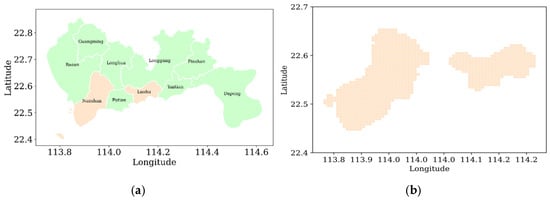
Figure 3.
Research area and rasterization, including (a) administrative division and (b) rasterization of Nanshan District and Luohu District.

Table 1.
Example of shared bicycle travel data.
3.2. Tensor Construction and Determination of Decomposition Rank
A rasterization method was used to divide Nanshan District and Luohu District into more detailed regions, as shown in Figure 3b. Rasterization can convert continuous vector data or graphics into discrete raster data, enabling efficient storage and analysis on computers and providing a visual display of geographic information. Gao et al. [39] conducted a study on the selection of grid size and found that the impact of built environment factors on shared bicycle usage becomes stable when the grid scale is 600 m × 600 m. Given the level of detail in the study, this research also sets the grid size to 600 m × 600 m, resulting in a total of 777 grids.
Shared bicycle travel data spanning a seven-day period (10–16 May 2021) was selected to capture a complete weekly cycle. This interval excluded holidays, academic events, and meteorological anomalies, with stable weather conditions providing a baseline scenario for analyzing usage patterns across spatio-temporal dimensions. Each grid was numbered, and using the shared bicycle travel data, a third-order tensor χ ∈ RI × J × K (I = J = 777, K = 168) was constructed. In this tensor, the first and second dimensions represent the grid numbers corresponding to the starting and ending points of each shared bicycle trip, while the third dimension represents the hour of the trip, with a total of 168 h in a week. χijk represents the shared bicycle travel volume from the i-th grid to the j-th grid during the k-th hour.
After constructing the tensor, the third-order tensor is subjected to CP decomposition. First, the rank r of the decomposition needs to be determined, which determines the number of sub-tensors after decomposition. The root means square error (RMSE) after CP decomposition [40] can be calculated using Equation (2):
where represents the elements of the tensor reconstructed after decomposition. Increasing r can reduce the decomposition error of the original tensor, but it also increases the number of extracted patterns. If r is too large, it can reduce the decomposition error, but may introduce atypical patterns; conversely, if r is too small, the decomposition error will be larger, and some important or classic patterns may be lost. Therefore, a balance between decomposition error and pattern extraction must be sought. The RMSE1 results corresponding to different values of r are shown in Figure 4.
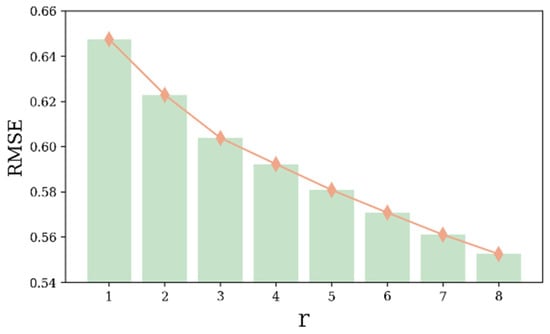
Figure 4.
RMSE corresponding to different r values.
Based on the elbow rule [41], the value of r is determined by calculating the change in curve slope and determining the position with the most significant change rate as the elbow. According to Figure 4, when the value of r is greater than 3, the rate of decrease of the loss function significantly decreases, indicating that a further increase in r has little impact on the loss function. Therefore, the value of r is 3.
3.3. Determination of Travel Patterns
After determining the decomposition rank as 3, the constructed three-way tensor was decomposed using CP, resulting in three sub-tensors, each corresponding to a distinct pattern. Figure 5 shows the time distribution characteristics of three travel patterns, namely, pattern 1 with the highest travel volume during morning, evening, and night rush hours (peak-high traffic pattern), pattern 2 with relatively stable travel volume throughout the day (steady traffic pattern), and pattern 3 with the highest travel volume during off-peak hours (off-peak high traffic pattern).
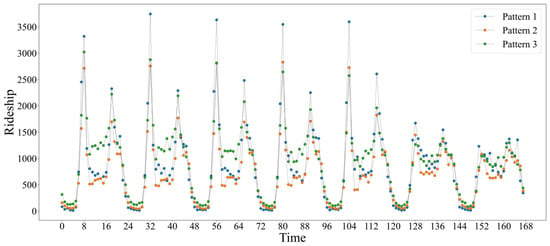
Figure 5.
Time distribution characteristics of three travel patterns.
The spatial distribution characteristics of the three extracted travel patterns are visualized in Figure 6. It can be seen that in the peak-high traffic pattern, the travel volume is mainly concentrated in the northern part of Nanshan District, which is a hub for high-tech industries in Shenzhen. In the steady traffic pattern, the travel volume is mainly concentrated in the southern part of Nanshan District, which contains large residential areas, including residential complexes and commercial areas. In the off-peak high traffic pattern, the travel volume is mainly concentrated in the southern part of Luohu District, which has inland ports, transportation hubs, and tourist attractions. The distribution characteristics of travel volume correspond to the functions of urban building clusters. Based on the time and spatial feature distributions of the travel patterns, the 777 grids are divided into 299 grids for the peak-high traffic pattern, 216 for the steady traffic pattern, and 262 for the off-peak high traffic pattern, as shown in Figure 7. From the time-space characteristics, these three patterns represent three clusters of bike-sharing trips.
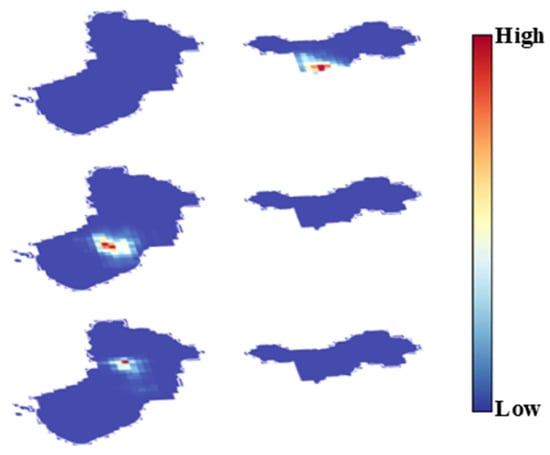
Figure 6.
Spatial distribution characteristics of three travel patterns.
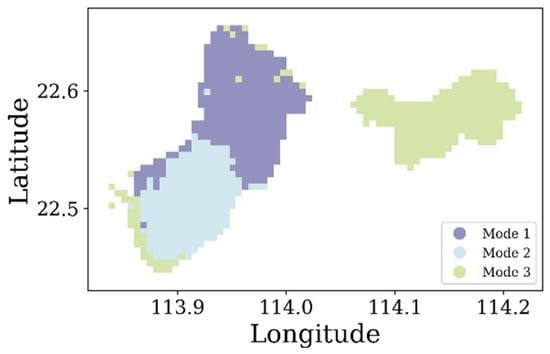
Figure 7.
Specific spatial distribution of travel patterns.
4. Experiments and Results
4.1. Model Training and Validation
This study selects 13 built environment variables to investigate their influence on bike-sharing travel patterns, with variable selection grounded in three key principles: (1) alignment with 5D theory [42] of built environment dimensions, including density, diversity, design, destination accessibility, and distance to transit; (2) empirical validation through prior bicycle travel behavior studies, such as the influence of built environment features on bike-sharing ridership [43], effects of built environment and weather on bike sharing demand [44], and nonlinear and threshold effects of the built environment on dockless bike-sharing [45]; and (3) elimination of multicollinearity via variance inflation factor (VIF) screening [46]. Figure 8 shows the VIF values of the 13 selected built environment factors. They are all less than the threshold value of 5, so there is no significant multicollinearity between the feature variables.
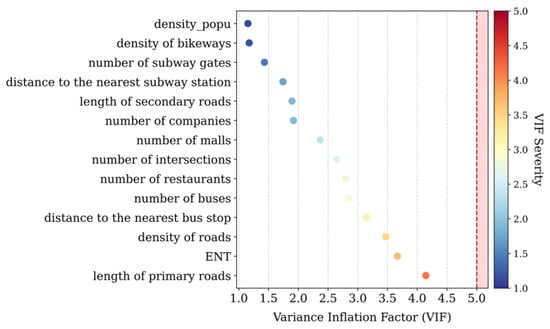
Figure 8.
VIF values of 13 building environmental factors.
The variable names, means, and variances are shown in Table 2. It should be noted that the number of POIs, such as companies and malls, is obtained by matching the POI latitude and longitude coordinates to the respective grid areas and then performing statistics. The lengths of the primary roads and secondary roads are calculated by first cutting the road lines using the grid contour and then calculating the road length within each grid. The road density is calculated by first determining the length within each grid and then dividing by the grid area. The land use mix entropy index (ENT) [47] is calculated using Equation (3):
where Pi is the percentage of the i-th type POI in each grid, n is the number of POIs in each grid, and the value of ENT is greater than 0. The larger the value, the higher the degree of land mixed use in that grid, and the more diverse the building functions within the region. The distance to the nearest subway station is obtained by first calculating the distance from each grid center point to the entrance and exit of each subway station and then taking the minimum value. The same applies to the distance to the nearest bus stop.

Table 2.
Relevant information on 13 variables.
Calculate the daily trip count of the grid in each pattern, and divide the calculation results into a training set, validation set, and test set according to the 8:1:1 ratio. Three indicators, namely, the coefficient of determination (R2), mean absolute error (MAE), and root mean square error (RMSE2), were selected to evaluate the performance of the model. They were calculated using Equations (4)–(6), respectively:
where yi represents the true value of the i-th sample, represents the average value of the sample, represents the predicted value of the i-th sample, and n represents the number of samples.
To comprehensively validate the performance of the Random Forest (RF) model, comparative experiments were conducted not only with ensemble-based LightGBM [48] and XGBoost [49] models, but also extended to neural network architectures, including Multilayer Perceptron (MLP) [50] and Convolutional Neural Networks (CNN) [7]. The evaluation results (Table 3) demonstrate that the RF model achieved the highest R2 score of 0.804, outperforming both gradient boosting models (LightGBM: 0.752; XGBoost: 0.768) and neural networks (MLP: 0.726; CNN: 0.712). Furthermore, the RF exhibited the lowest prediction errors, with MAE and RMSE2 values decreased significantly compared to neural networks. This superior performance can be attributed to three key factors: (1) RF’s inherent ability to handle high-dimensional tabular data through feature randomness and bootstrap aggregation, effectively mitigating overfitting risks common in neural networks with limited training samples; (2) the automatic feature selection mechanism embedded in RF’s decision trees, which provides an advantage over neural networks that require explicit feature engineering; (3) the stability of RF in capturing non-linear relationships without demanding extensive hyperparameter tuning, whereas neural networks showed higher sensitivity to initialization parameters and training epochs. These findings collectively justify the selection of RF as the optimal approach for the subsequent analysis in this study.

Table 3.
Performance comparison of different models.
4.2. Importance Analysis of Features
SHAP is used to interpret the model and rank the importance of features based on their contribution to the model output. For the peak-high traffic pattern, Figure 9a shows that the length of the primary roads has the greatest impact on bike-sharing usage, with the influence increasing as the road length increases. This suggests that users are more inclined to ride shared bikes along primary roads rather than on other roads, as longer primary roads offer more accessibility and convenience, making shared bikes the preferred pattern of travel. Additionally, the distance to the nearest subway station has a significant impact, with a greater influence as the distance decreases, indicating that shared bikes are largely used in conjunction with the subway. On the other hand, the distance to the nearest bus stop has a smaller impact, suggesting that shared bike users prefer the subway over buses in public transportation. The number of companies is also a significant factor promoting shared bike usage, concentrating on travel demand, particularly during peak commuting hours.

Figure 9.
SHAP values of the features of three travel patterns, including (a) peak-high traffic pattern, (b) steady traffic pattern, and (c) off-peak high traffic pattern.
For the steady traffic pattern, Figure 9b indicates that the factor of ENT has the greatest impact on bike-sharing usage, with the influence increasing as ENT decreases. This suggests that more homogeneous land use leads to higher shared bike usage. This is because homogeneous land use means more concentrated facilities and services within the area, making it easier for users to reach various destinations, such as residential areas, commercial districts, and public places, thus reducing travel distances and encouraging shared bike usage. Additionally, homogeneous land use suggests that urban planning places greater emphasis on the feasibility of walking and cycling, offering better road infrastructure such as bike lanes and encouraging people to ride shared bikes. The importance of road density and bikeway density further supports the aforementioned speculation. Moreover, shopping malls also attract more shared bike usage. Travel in this pattern is generally similar to the peak-high traffic pattern, but with lower flow and more concentrated travel demands, resulting in a faster overall pace of life. As a result, more people tend to choose more convenient and rapid modes of transportation. This is related to economic development, land use intensity, population, and road density.
For the off-peak high traffic pattern, Figure 9c shows that the number of malls and interests has the greatest impact on bike-sharing usage, with travel volume increasing as the number of POIs rises. Additionally, factors such as road density, primary road length, and the distance to the nearest subway station positively promote shared bike usage. This is because more roads and better network connectivity provide more convenient transportation conditions, on which shared bike usage relies. The key feature of this pattern is that travel volume during off-peak periods is still significant, as users primarily travel for leisure purposes. Travel demand exhibits a more evenly distributed temporal pattern with reduced peak-to-average ratios.
4.3. Importance Analysis of Feature Combinations
After analyzing the importance of individual features, this study further investigates the impact of different feature combinations on bike-sharing travel patterns. The top five features with the greatest impact on the peak-high traffic pattern are selected: length of the primary roads, distance to the nearest subway station, number of companies, density of roads, and length of the secondary roads. A heatmap of these feature relationships is shown in Figure 10a. The heatmap provides an intuitive understanding of the correlation between features and the relationship between features and target variables. In absolute value terms, the length of the primary roads exhibits the strongest positive correlation with the density of roads among all variables analyzed, the correlation between length of the primary roads and length of the secondary roads is the weakest, and the distance to the nearest subway station is negatively correlated with all other features or the target variable.
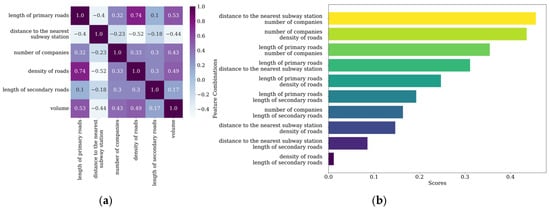
Figure 10.
Feature heatmap and feature combination importance of peak-high traffic pattern, including (a) heatmap and (b) importance ranking.
The five features are combined in pairs, resulting in ten different feature combinations. These combinations are evaluated and ranked for their importance using the RF model, with the results shown in Figure 10b. The feature combination (distance to the nearest subway station, number of companies) and (number of companies, density of roads) have the most significant influence on the peak-high traffic pattern. The mechanism can be attributed to: (1) the high enterprise density around the subway station forms a composite node of “employment-transportation”, which stimulates the short-distance substitution effect of shared bicycles by shortening the terminal connection distance of commuters; (2) the combination of enterprise agglomeration and high road network density strengthens the matching efficiency of occupational and residential space. Especially during commuting peak hours, the dense road layout eases the riding impedance, making shared bicycles the Pareto optimal solution [51] to overcome the spatio-temporal constraints of the “last kilometer”. The above interaction effects reveal the directional shaping effect of the coupling mode of urban functional mixing degree and transportation infrastructure on travel patterns.
Figure 11a shows the interaction impact between the distance to the nearest subway station and the number of companies on the target variable. The more companies there are and the closer the subway station is, the more likely it is to promote shared bike usage. Figure 11b illustrates the interaction effect between the length of the primary roads and the distance to the nearest subway station on the target variable. It can be seen that when the length of the main roads is around 1 km, the closer the subway station is, the more it promotes shared bike usage.
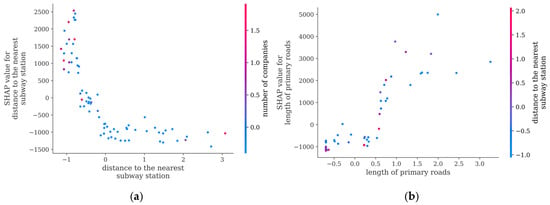
Figure 11.
Interactive impact of specific feature combinations of peak-high traffic pattern on travel volume, including (a) distance to the nearest subway station and the number of companies, and (b) length of the primary roads and distance to the nearest subway station.
The top five features with the greatest impact on the steady traffic pattern are selected: ENT, number of malls, density of roads, density of bikeways, and number of companies. A heatmap of these feature relationships is shown in Figure 12a. In absolute value terms, it is evident that the correlation between the number of malls and the number of companies is the strongest, the correlation between ENT and the density of bikeways is the weakest, and ENT is negatively correlated with all other features and the target variable.
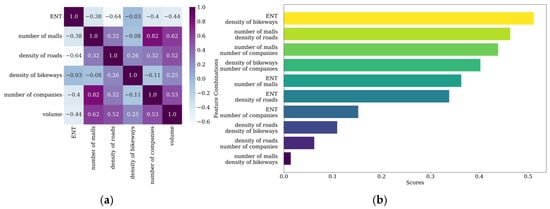
Figure 12.
Feature heatmap and feature combination importance of steady traffic pattern, including (a) heatmap and (b) importance ranking.
The five features are combined in pairs, resulting in ten different feature combinations. These combinations are evaluated and ranked for their importance using the RF model, with the results shown in Figure 12b. The feature combinations (ENT, density of bikeways) and (number of malls, density of roads) exert the most significant impacts on the steady traffic pattern. The mechanisms are twofold: (1) High bikeway density synergizes with low ENT values (indicating land use specialization) to create dedicated slow-mobility corridors, reducing detour distances through minimized land use interference, where the negative ENT effect highlights that specialized recreational zones enhance bike-sharing efficiency by streamlining destination-oriented trip chains; (2) mall agglomerations coupled with dense road networks create commercial gravity cores, improving multi-destination accessibility to stabilize ridership, while road topology connectivity mitigates steady traffic pattern uncertainty. These interactions highlight the co-regulatory mechanisms between urban functional coupling and road network resilience in shaping demand stability.
Figure 13 shows the interaction effect between these two features and the target variable, demonstrating that more malls and greater road density promote shared bike usage. The distribution of malls mainly consists of single large malls and clusters of more than three malls. For the steady traffic mode, mall clusters have a greater attraction for shared bikes, though this needs to be combined with infrastructure such as roads.
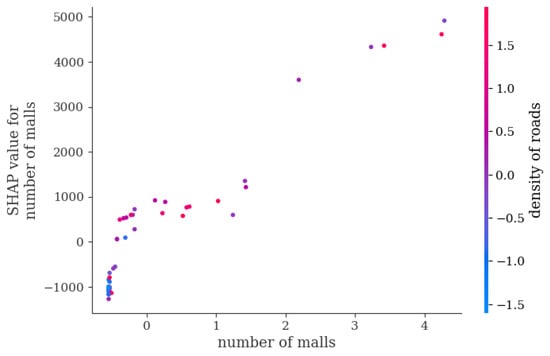
Figure 13.
Interactive impact of specific feature combinations of steady traffic patterns on travel volume.
The top five features with the greatest impact on the off-peak high traffic pattern are selected: number of malls, number of interests, density of roads, length of the primary roads, and distance to the nearest subway station. A heatmap of these feature relationships is shown in Figure 14a. In absolute value terms, the correlation between the number of malls and the number of interests is the strongest, the correlation between the density of roads and the length of the primary roads is also strong, while the correlation between the number of malls and the distance to the nearest subway station is weaker.
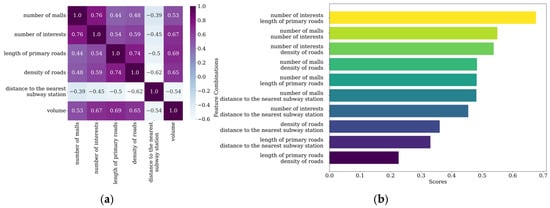
Figure 14.
Feature heatmap and feature combination importance of the off-peak high traffic pattern, including (a) heatmap and (b) importance ranking.
The five features are combined in pairs, resulting in ten different feature combinations. These combinations are evaluated and ranked for their importance using the RF model, with the results shown in Figure 14b. The combinations (number of interests, length of primary roads) and (number of malls, number of interests) most significantly influence the off-peak high traffic pattern. The mechanisms are twofold: (1) High interest density synergizes with primary road networks to form tourist accessibility corridors, reducing inter-attraction cycling distances and triggering “recreation-transfer” chain reactions, with road topology enhancing destination aggregation; (2) Spatially coupled malls and interests create commercial–recreational hybrid hubs, stabilizing ridership through reduced spatiotemporal friction in multi-purpose trips. These interactions demonstrate how recreation-oriented land use integration and arterial road synergy co-regulate flexible travel demand.
Figure 15a demonstrates a non-monotonic relationship, with the SHAP value peaking at two interest points, indicating maximal model sensitivity to this feature. Beyond this threshold, incremental additions progressively weaken the variable’s predictive influence, likely reflecting demand saturation effects that divert commuters to alternative transport modes. Figure 15b shows that the greater the number of attractions and the closer the subway station is, the more shared bikes are used.
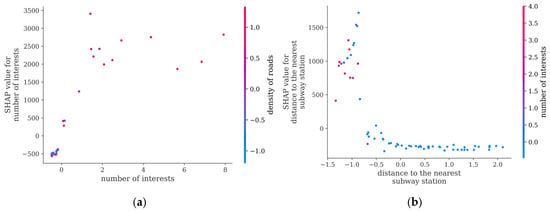
Figure 15.
Interactive impact of specific feature combinations of off-peak high traffic pattern on travel volume, including (a) distance to the nearest subway station and the number of companies, and (b) length of the primary roads and distance to the nearest subway station.
5. Conclusions
This study constructs a third-order tensor for bike-sharing trip volume based on a multi-source dataset and utilizes the CP decomposition algorithm to extract three bike-sharing travel patterns. From the perspective of time distribution, the peak-high traffic pattern shows the highest trip volume during peak hours, the steady traffic pattern has a relatively small trip volume across all hours, and the off-peak high traffic pattern exhibits the highest trip volume during off-peak hours. From the spatial distribution perspective, each pattern exhibits spatial clustering, with the spatial centrality located in different regions. Furthermore, the trip volume decreases from the center towards the outskirts. Moreover, the RF model is used to predict the impact of built environment factors on shared bicycle travel patterns. Based on the current experimental results, the main conclusions drawn from this study are as follows:
- (1)
- For the peak-high traffic pattern, factors such as the length of the primary roads and distance to the nearest subway station have a significant impact. It is recommended to increase the number of shared bikes around major roads and near subway stations, while also constructing bike lanes to enhance convenience and safety. Additionally, attention should be given to the large demand for bikes generated by commuting. For example, travel is concentrated in the northern part of Nanshan District, leading to a high volume of trips during peak hours and little usage during off-peak hours. This requires management departments to make targeted bike-sharing adjustments to avoid situations where bikes are unavailable during peak hours and not used during off-peak hours.
- (2)
- For the steady traffic pattern, areas such as dedicated commercial districts, residential areas, and office areas are more attractive for bike-sharing usage. It is recommended to increase bike-sharing availability in areas with single-use land and clear demand while ensuring an adequate supply near places like shopping malls to meet user needs. For example, in the southern part of Nanshan District, during peak hours, attention should be given to the timely dispatch of shared bikes in these areas, with consideration of commuting as the primary purpose.
- (3)
- For the off-peak high traffic pattern, scenes such as tourist interests and shopping malls generate more shared bike trips. It is recommended to deploy more shared bikes in these areas while also paying attention to the construction of road infrastructure. It is advised not to blindly increase the number of interests in urban planning to avoid suppressing bike-sharing use due to exceeding a certain threshold. For example, in Luohu District, trips are relatively dispersed. There is a high demand for bikes during peak hours, and considerable usage occurs during off-peak hours. Management departments should adopt more proactive dispatch strategies, responding more frequently and promptly to user needs to maintain the availability and efficiency of bike-sharing services.
By identifying different shared bike travel patterns and their spatiotemporal characteristics, urban planners can allocate resources more precisely. Increasing bike supply in certain areas during specific times can reduce traffic congestion and improve transportation efficiency. Bike-sharing companies can offer more personalized services, such as setting up more parking spaces in high-demand areas or offering discounts during peak hours to attract and retain users. Research on the impact of urban built environments on different travel patterns helps urban managers formulate policies to encourage low-carbon travel modes, reduce dependence on private cars, lower carbon emissions, and promote sustainable urban development.
However, this study also has limitations. Given the data collection constraints limiting the current study to a 7-day observation period, the findings could be strengthened by future research incorporating longitudinal data spanning multiple seasons to enhance the robustness of the conclusions. Additionally, the urban built environment is just one of many factors influencing travel patterns. Other factors (such as weather, season, holidays, and economic fluctuations) have a significant impact on travel patterns. Among them, temperature changes not only affect daily travel needs [52], but are also related to cycling safety [53], and the differences in safety perception may further regulate individual cycling behavior choices [54]. Future research needs to integrate such dynamic variables to enhance the universality and explanatory power of the travel behavior model.
Meanwhile, three critical research gaps are identified: (1) the exclusion of policy-sensitive variables, such as bike-sharing regulations and infrastructure investments, which can influence the formation of patterns; (2) insufficient integration of real-time environmental data streams that influence spontaneous mobility decisions; (3) under-explored feedback mechanisms between infrastructure evolution and policy interventions. Future research should prioritize developing adaptive modeling frameworks that synchronize longitudinal built environment metrics with policy lifecycle stages, while incorporating dynamic data assimilation techniques to capture the interplay between physical infrastructure and behavioral adaptability.
Author Contributions
Conceptualization, Y.S. (Yonggang Shen) and Z.Y.; methodology, Y.S. (Yonggang Shen), L.Z. and Y.S. (Yancun Song); software, L.Z. and C.W.; validation, L.Z., Y.S. (Yancun Song) and Z.Y.; investigation, Y.S. (Yonggang Shen), Y.S. (Yancun Song) and C.W.; resources, Y.S. (Yonggang Shen) and Z.Y.; data curation, L.Z. and Y.S. (Yancun Song); writing—original draft preparation, L.Z.; visualization, L.Z. and Y.S. (Yancun Song); supervision, Z.Y.; project administration, Y.S. (Yonggang Shen) and Z.Y. All authors have read and agreed to the published version of the manuscript.
Funding
This research was funded by ‘Postdoctoral Fellowship Program of CPSF, grant number GZC20241517‘, ‘Zhejiang Provincial Natural Science Foundation of China, grant number LTGG23E080001’, and ‘National Key Research and Development Program, grant number 2022YFF06069003-03’.
Institutional Review Board Statement
Not applicable.
Informed Consent Statement
Not applicable.
Data Availability Statement
The original data presented in the study are openly available at https://opendata.sz.gov.cn/wap/.
Conflicts of Interest
The authors declare no conflicts of interest.
Abbreviations
The following abbreviations are used in this manuscript:
| POI | Points of interest |
| OD | Origin-destination |
| CP | CANDECOMP/PARAFAC |
| RF | Random forest |
| SHAP | Shapley additive explanations |
References
- Jiang, J.A.; Chen, S.L. Exploring the pathways of achieving carbon peaking and carbon neutrality targets in the provinces of the Yellow River basin of China. Sustainability 2024, 16, 6553. [Google Scholar] [CrossRef]
- Rimoldi, A.; Cenedese, C.; Padoan, A.; Dörfler, F.; Lygeros, J. Urban traffic congestion control: A DeePC change. In Proceedings of the 2024 European Control Conference, Stockholm, Sweden, 25–28 June 2024. [Google Scholar] [CrossRef]
- Tan, X.Y.; Zhu, X.L.; Li, Q.; Li, L.N.; Chen, J. Tidal phenomenon of the dockless bike-sharing system and its causes: The case of Beijing. Int. J. Sustain. Transp. 2022, 16, 287–300. [Google Scholar] [CrossRef]
- Figliozzi, M.; Tipagornwong, C. Impact of last mile parking availability on commercial vehicle costs and operations. Supply Chain Forum 2017, 18, 60–68. [Google Scholar] [CrossRef]
- Cui, Y.F.; Lv, W.F.; Wang, Q.; Du, B.W. Usage demand forecast and quantity recommendation for urban shared bicycles. In Proceedings of the 2018 International Conference on Cyber-Enabled Distributed Computing and Knowledge Discovery, Zhengzhou, China, 18–20 October 2018. [Google Scholar] [CrossRef]
- Dong, X.Y.; Zhang, B.; Wang, Z.H. Impact of land use on bike-sharing travel patterns: Evidence from large scale data analysis in China. Land Use Policy 2023, 133, 106852. [Google Scholar] [CrossRef]
- Wang, B.; Vu, H.L.; Kim, I.; Cai, C. Short-term traffic flow prediction in bike-sharing networks. J. Intell. Transport. Syst. 2022, 26, 461–475. [Google Scholar] [CrossRef]
- Du, M.Y.; Cheng, L. Better understanding the characteristics and influential factors of different travel patterns in free-floating bike sharing: Evidence from Nanjing, China. Sustainability 2018, 10, 1244. [Google Scholar] [CrossRef]
- Xing, Y.Y.; Wang, K.; Lu, J.J. Exploring travel patterns and trip purposes of dockless bike-sharing by analyzing massive bike-sharing data in Shanghai, China. J. Transp. Geogr. 2020, 87, 102787. [Google Scholar] [CrossRef]
- Kou, Z.Y.; Cai, H. Understanding bike sharing travel patterns: An analysis of trip data from eight cities. Phys. A 2019, 515, 785–797. [Google Scholar] [CrossRef]
- Li, Q.M.; Xu, W.P. The impact of COVID-19 on bike-sharing travel pattern and flow structure: Evidence from Wuhan. Camb. J. Reg. Econ. Soc. 2022, 15, 477–494. [Google Scholar] [CrossRef]
- Ma, J.Z.; Zheng, C.J.; Yu, M.; Shen, J.X.; Zhang, H.Y.; Wang, Y.Y. The analysis of spatio-temporal characteristics and determinants of dockless bike-sharing and metro integration. Transp. Lett. 2024, 16, 182–195. [Google Scholar] [CrossRef]
- Wang, F.Y.; Yin, C.Y.; Chang, X.M.; Zhang, X.Y.; He, Z.B. Exploring the relationship between built environment and bike-sharing demand: Does the trip length matter? Transp. Plan. Technol. 2024. [Google Scholar] [CrossRef]
- Quan, Y.F.; Wu, X.; Zhu, Z.J.; Liu, C.Y. Origin-destination spatial-temporal patterns of dockless shared bikes based on shopping activities and its application in urban planning: The case of Nanjing. Systems 2024, 12, 506. [Google Scholar] [CrossRef]
- Wang, F.Y.; Omar, S.; Wu, Y.C.; Zhang, X.Y.; He, J. Analysis of bike-sharing travel behavior using multi-day OD trip data. In Proceedings of the 23rd Joint COTA International Conference of Transportation Professionals, Beijing, China, 15–17 July 2023. [Google Scholar] [CrossRef]
- Peng, C.B.; Jin, X.G.; Wong, K.C.; Shi, M.X.; Liò, P. Collective human mobility pattern from taxi trips in urban area. PLoS ONE 2012, 7, e34487. [Google Scholar] [CrossRef]
- Li, Q.M.; Zhang, E.J.; Luca, D.; Fuerst, F. The travel pattern difference in dockless micro-mobility: Shared e-bikes versus shared bikes. Transport. Res. Part D Transport. Environ. 2024, 130, 104179. [Google Scholar] [CrossRef]
- Dong, J.; Chen, B.; He, L.; Ai, C.; Zhang, F.; Guo, D.; Qiu, X. A spatio-temporal flow model of urban dockless shared bikes based on points of interest clustering. ISPRS Int. J. Geo-Inf. 2019, 8, 345. [Google Scholar] [CrossRef]
- Chen, G.Y.; Wei, Z.C. Exploring the impacts of built environment on bike-sharing trips on weekends: The case of Guangzhou. Int. J. Sustain. Transp. 2024, 18, 315–327. [Google Scholar] [CrossRef]
- Ethier, B.G.; Wilson, J.S.; Camhi, S.M.; Shi, L.; Troped, P.J. An analysis of built environment characteristics in daily activity spaces and associations with bike share use. Travel Behav. Soc. 2024, 37, 100850. [Google Scholar] [CrossRef]
- Song, Y.C.; Luo, K.; Shi, Z.Y.; Zhang, L.; Shen, Y.G.; Tong, H.Y.; Torrao, G. Nonlinear influence and interaction effect on the imbalance of metro-oriented dockless bike-sharing system. Sustainability 2024, 16, 349. [Google Scholar] [CrossRef]
- Li, Z.T.; Shang, Y.Z.; Zhao, G.W.; Yang, M.Z. Exploring the multiscale relationship between the built environment and the metro-oriented dockless bike-sharing usage. Int. J. Environ. Res. Public Health 2022, 19, 2323. [Google Scholar] [CrossRef]
- Yang, H.T.; Zheng, R.; Li, X.; Huo, J.H.; Yang, L.C.; Zhu, T. Nonlinear and threshold effects of the built environment on e-scooter sharing ridership. J. Transp. Geogr. 2022, 104, 103453. [Google Scholar] [CrossRef]
- Zhuang, C.G.; Li, S.Y.; Tan, Z.Z.; Feng, G.; Wu, Z.F. Nonlinear and threshold effects of traffic condition and built environment on dockless bike sharing at street level. J. Transp. Geogr. 2022, 102, 103375. [Google Scholar] [CrossRef]
- Zhang, Y.; Thomas, T.; Brussel, M.; Maarseveen, M.V. Exploring the impact of built environment factors on the use of public bikes at bike stations: Case study in Zhongshan, China. J. Transp. Geogr. 2017, 58, 59–70. [Google Scholar] [CrossRef]
- Guo, Y.Y.; He, S.Y. Built environment effects on the integration of dockless bike-sharing and the metro. Transport. Res. Part D Transport. Environ. 2020, 83, 102335. [Google Scholar] [CrossRef]
- Silvestri, F.; Babaei, S.H.; Coppola, P. Improving urban cyclability and perceived bikeability: A decision support system for the city of Milan, Italy. Sustainability 2024, 16, 8188. [Google Scholar] [CrossRef]
- Coppola, P.; Silvestri, F. Gender inequality in safety and security perceptions in railway stations. Sustainability 2021, 13, 4007. [Google Scholar] [CrossRef]
- Villarrasa-Sapiña, I.; Toca-Herrera, J.L.; Pellicer-Chenoll, M.; Taczanowska, K.; Rueda, P.; Devís-Devís, J. Effects of meteorology on bike-sharing: Cases of 13 cities using non-linear analyses. Cities 2024, 155, 105457. [Google Scholar] [CrossRef]
- Kolda, T.G.; Bader, B.W. Tensor decompositions and applications. SIAM Rev. 2009, 51, 455–500. [Google Scholar] [CrossRef]
- Tang, H.; Fei, S.X.; Shi, X.Y. Revealing travel patterns from dockless bike-sharing data based on tensor decomposition. In Proceedings of the 12th International Symposium on Visual Information Communication and Interaction, Shanghai, China, 20 September 2019. [Google Scholar] [CrossRef]
- Lespinats, S.; Colange, B.; Dutykh, D. Nonlinear Dimensionality Reduction Techniques: A Data Structure Preservation Approach; Springer International Publishing: Cham, Switzerland, 2022. [Google Scholar] [CrossRef]
- Phan, A.H.; Tichavský, P.; Cichocki, A. Deflation method for CANDECOMP/PARAFAC tensor decomposition. In Proceedings of the 2014 IEEE International Conference on Acoustics, Speech and Signal Processing, Florence, Italy, 4–9 May 2014. [Google Scholar] [CrossRef]
- Hayashi, K.; Kishimoto, K.; Shimbo, M. Binarized embeddings for fast, space-efficient knowledge graph completion. IEEE Trans. Knowl. Data Eng. 2023, 35, 141–153. [Google Scholar] [CrossRef]
- Tang, J.J.; Wang, X.L.; Zong, F.; Hu, Z. Uncovering spatio-temporal travel patterns using a tensor-based model from metro smart card data in Shenzhen, China. Sustainability 2020, 12, 1475. [Google Scholar] [CrossRef]
- Rigatti, S.J. Random forest. J. Insur. Med. 2017, 47, 31–39. [Google Scholar] [CrossRef]
- Slack, D.; Hilgard, S.; Jia, E.; Singh, S.; Lakkaraju, H. Fooling lime and SHAP: Adversarial attacks on post hoc explanation methods. In Proceedings of the 3rd AAAI/ACM Conference on AI, Ethics, and Society, New York, NY, USA, 7–8 February 2020. [Google Scholar] [CrossRef]
- Choi, J.E.; Shin, J.W.; Shin, D.W. Vector SHAP values for machine learning time series forecasting. J. Forecast. 2025, 44, 635–645. [Google Scholar] [CrossRef]
- Gao, F.; Li, S.Y.; Tan, Z.Z.; Wu, Z.F.; Zhang, X.M.; Huang, G.P.; Huang, Z.W. Understanding the modifiable areal unit problem in dockless bike sharing usage and exploring the interactive effects of built environment factors. Int. J. Geogr. Inf. Sci. 2021, 35, 1905–1925. [Google Scholar] [CrossRef]
- Wang, J.Y.; Wu, J.J.; Wang, Z.; Gao, F.; Xiong, Z. Understanding urban dynamics via context-aware tensor factorization with neighboring regularization. IEEE Trans. Knowl. Data Eng. 2019, 32, 2269–2283. [Google Scholar] [CrossRef]
- Hamka, M.; Ramdhoni, N. K-means cluster optimization for potentiality student grouping using elbow method. In Proceedings of the 3rd International Conference on Engineering and Applied Sciences, Purwokerto, Indonesia, 26 July 2021. [Google Scholar] [CrossRef]
- Zhang, Y.F.; Jian, C.; Qiu, Z.X. Nonlinear impact analysis of built environment on urban road traffic safety risk. Syst. Sci. Control Eng. 2023, 11, 2268121. [Google Scholar] [CrossRef]
- Zhu, L.; Ali, M.; Macioszek, E.; Aghaabbasi, M.; Jan, A. Approaching sustainable bike-sharing development: A systematic review of the influence of built environment features on bike-sharing ridership. Sustainability 2022, 14, 5795. [Google Scholar] [CrossRef]
- El-Assi, W.; Salah Mahmoud, M.; Nurul Habib, K. Effects of built environment and weather on bike sharing demand: A station level analysis of commercial bike sharing in Toronto. Transportation 2017, 44, 589–613. [Google Scholar] [CrossRef]
- Chen, M.; Wang, T.; Liu, Z.; Li, Y.; Tu, M. Nonlinear and threshold effects of the built environment on dockless bike-sharing. Sustainability 2024, 16, 7690. [Google Scholar] [CrossRef]
- Salmerón, R.; García, C.B.; García, J. Variance inflation factor and condition number in multiple linear regression. J. Stat. Comput. Simul. 2018, 88, 2365–2384. [Google Scholar] [CrossRef]
- Song, Y.; Merlin, L.; Rodriguez, D. Comparing measures of urban land use mix. Comput. Environ. Urban Syst. 2013, 42, 1–13. [Google Scholar] [CrossRef]
- Aydin, Z.E.; Erdem, B.I.; Cicek, Z.I.E. Prediction bike-sharing demand with gradient boosting methods. Pamukkale Univ. J. Eng. Sci. 2023, 29, 824–832. [Google Scholar] [CrossRef]
- Chen, T.Q.; Guestrin, C. XGBOOST: A scalable tree boosting system. In Proceedings of the 22nd ACM SIGKDD International Conference on Knowledge Discovery and Data Mining, San Francisco, CA, USA, 13–17 August 2016. [Google Scholar] [CrossRef]
- Simon, R.; Elena, M.; Omar, A.K. Predictive modeling for optimization of field operations in bike-sharing systems. In Proceedings of the 2019 6th Swiss Conference on Data Science (SDS), Bern, Switzerland, 14–15 June 2019. [Google Scholar] [CrossRef]
- Wang, X.X.; Zheng, S.Q.; Wang, L.Q.; Han, S.; Liu, L. Multi-objective optimal scheduling model for shared bikes based on spatiotemporal big data. J. Clean. Prod. 2023, 421, 138362. [Google Scholar] [CrossRef]
- Miranda-Moreno, L.F.; Lahti, A.C. Temporal trends and the effect of weather on pedestrian volumes: A case study of Montreal, Canada. Transport. Res. Part D Transport. Environ. 2013, 22, 54–59. [Google Scholar] [CrossRef]
- Hsu, C.K.; Rodríguez, D.A. A comparison of heat effects on road injury frequency between active travelers and motorized transportation users in six tropical and subtropical cities in Taiwan. Soc. Sci. Med. 2024, 360, 117333. [Google Scholar] [CrossRef] [PubMed]
- Márquez, L.; Cantillo, V.; Arellana, J. How do the characteristics of bike lanes influence safety perception and the intention to use cycling as a feeder mode to BRT? Travel Behav. Soc. 2021, 24, 205–217. [Google Scholar] [CrossRef]
Disclaimer/Publisher’s Note: The statements, opinions and data contained in all publications are solely those of the individual author(s) and contributor(s) and not of MDPI and/or the editor(s). MDPI and/or the editor(s) disclaim responsibility for any injury to people or property resulting from any ideas, methods, instructions or products referred to in the content. |
© 2025 by the authors. Licensee MDPI, Basel, Switzerland. This article is an open access article distributed under the terms and conditions of the Creative Commons Attribution (CC BY) license (https://creativecommons.org/licenses/by/4.0/).